How do I play up to 64 txt files at once. 16 digits can be 1's or 0's loaded as toggle states.
So I have 64 txt files containing 16 digits that could be a 1 or 0. these digits are used as toggle states for my sequencer. the state of a toggle is sent to [s seqstep1] to [s seqstep16] and recieved to its 1 of the 16 toggles boxes in the sequencer. When a sequence is loaded a file path with the sequence number attached to it like this for example pattern-1.txt to pattern-64.tx there can be up to 64 sequences play at any given time based on the [s seqstep1 ] for the loaded txt file.
I am able to play them one at a time by changing the number atom and pushing play but im not sure how I should go about loading and playing all 64 txt files at once.
The below screen shot is how the sound is trigger using the [OBBangOnMetronome] abstract. The outlet is sent to second inlet of [OBPlayPadSample]. The first inlet is the selected sequence (the sequence that we want to play) number atom.
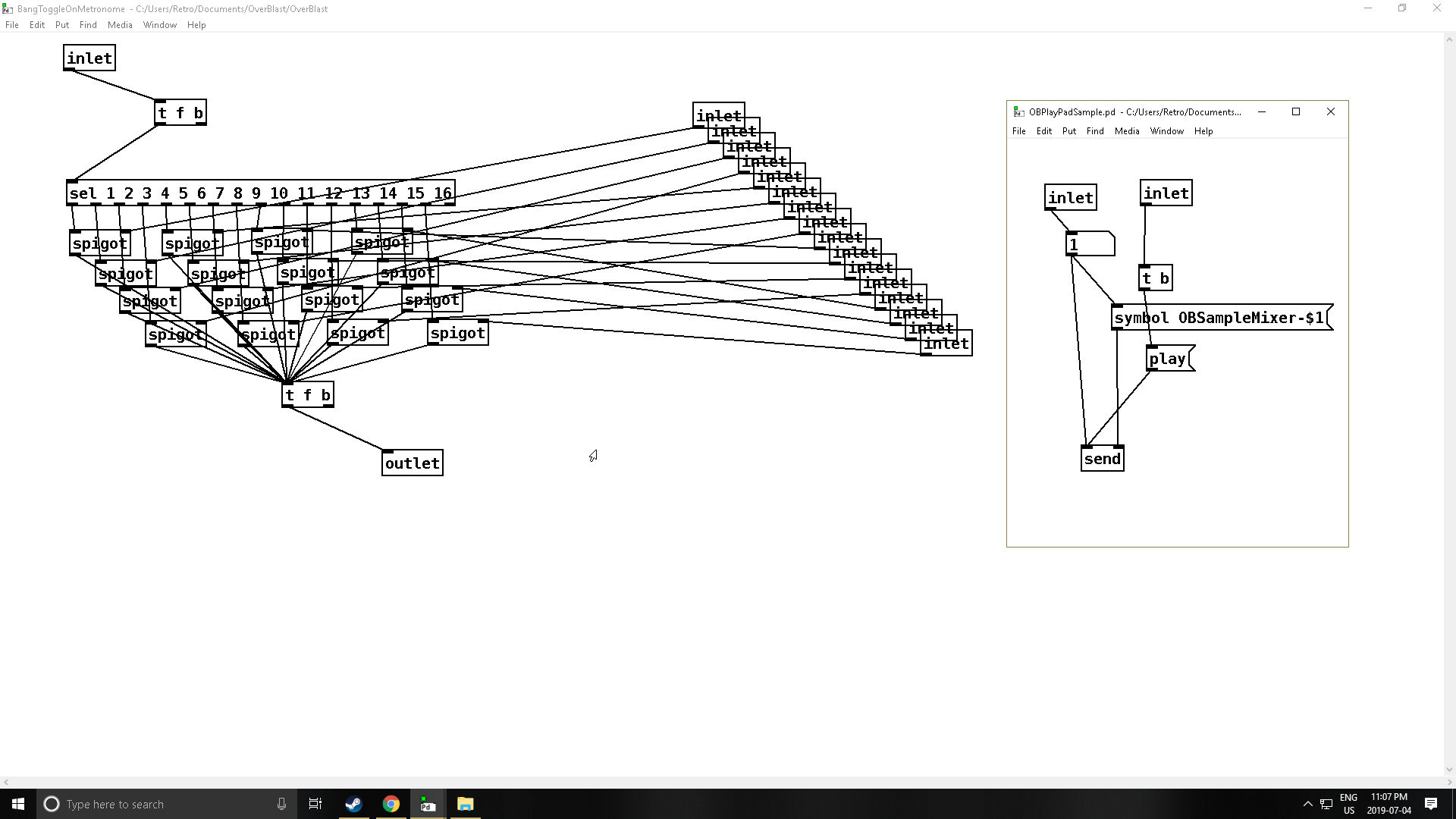
I need a a [Play all] button is the easiest way I can describe it. 
The last screen shot is simply for visual representation of how the sequencer looks.
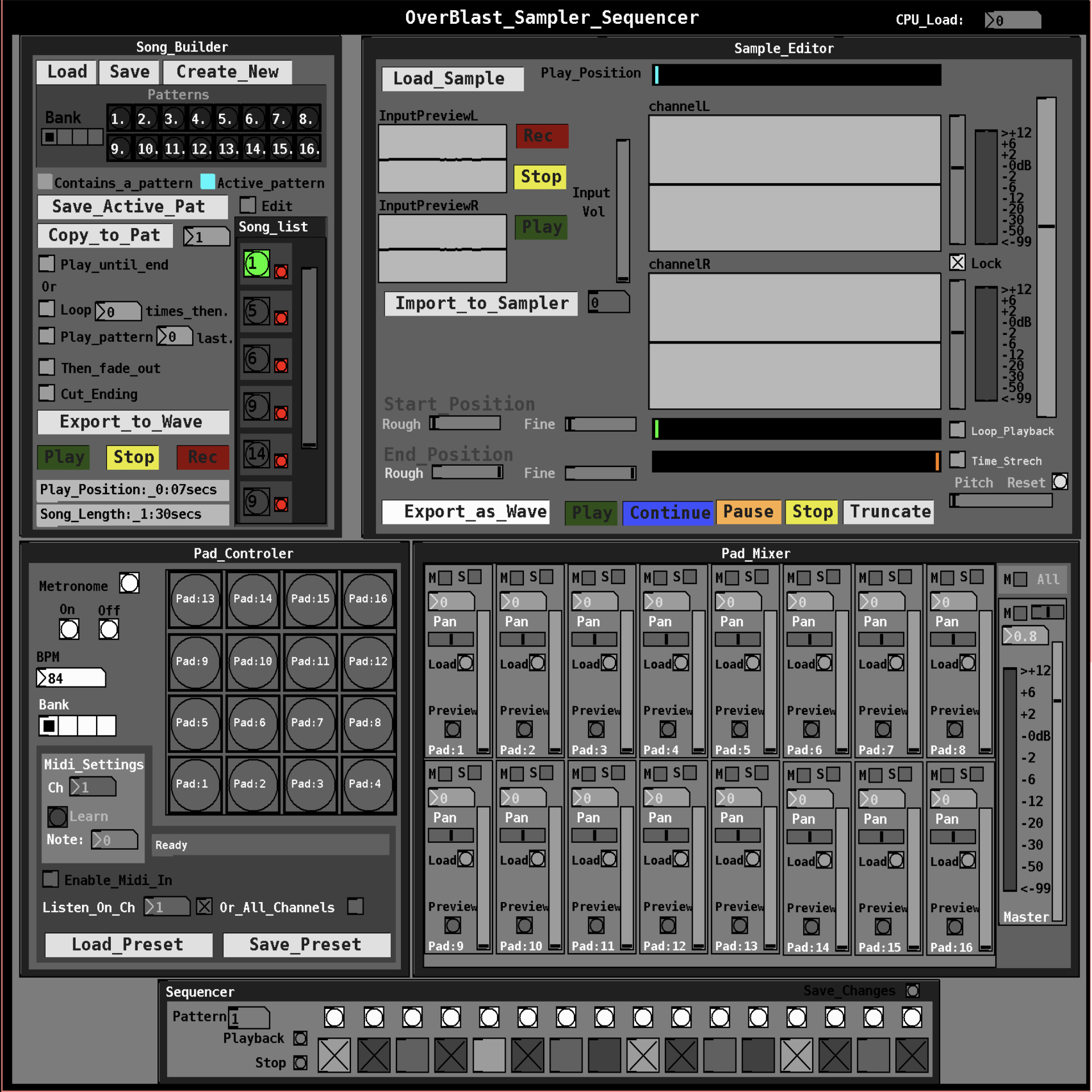
About my patch "OverBlast" a sampler sequencer and its current state.
Here is the patch that I have been working on for the past few months. OverBlast is a sampler sequencer that will be used as the UI for a DIY midi workstation with a Raspberry pi. And now with a lot of help from people in this forum I have been able to play midi sequences from midi hardware which was a huge step in its development process. Boy let me tell you learning puredata has been an experience that taught me to learn from the headaches and appreciate the highs. lol
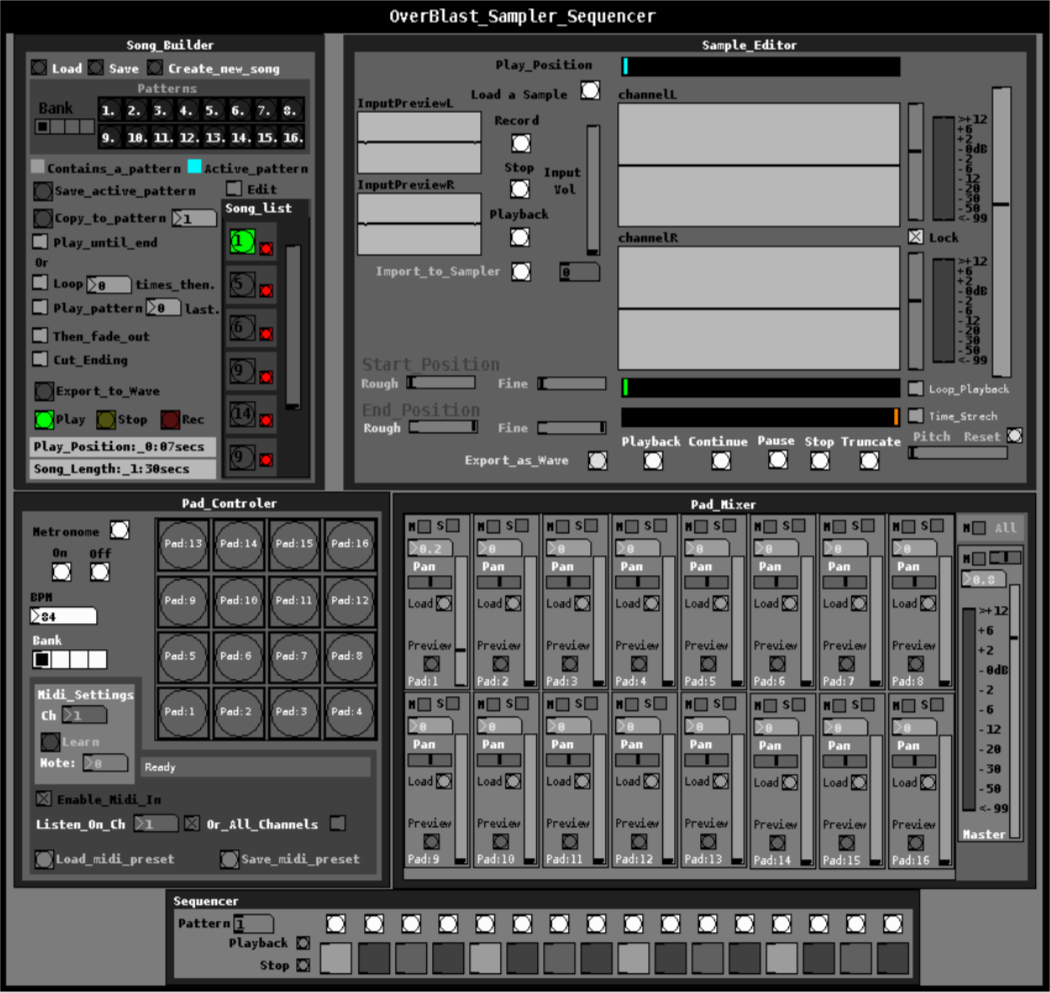
In its current state I have been At this point there are a few known bugs. listed below.
Known Bugs
- Sample Editor - Truncate btn dose not work correctly. saves whatever is in soundfiler buffer should clip start and end positions.
- Sample Editor - Loop playback toggle dose not do anything at the moment. sample will automaticly loop.
- Sample Editor - When start and end positions are adjusted the patch will crash the next time the sample is played or looped
- Sample Editor - Loop playback toggle dose not do anything at the moment. sample will automaticly loop.
- Sample Editor - Time stretch dose not to any thing. pitch slider will only changes the pitch. Time stretch should take in account the pitch and bmp to make it a true time strecth.
- Sample Editor - Loop playback toggle dose not do anything at the moment. sample will automaticly loop.
- Sample Editor - Export as Wave dose not do anything at the moment.
- Sequencer dose not work.. WIP contains only ui design
- Song builder does not work. WIP contains only ui design
With that said if you wish to play around with this patch it will more then likely crash while using the sample editor if the start and end positions are adjusted as there is still work to be done with it. The only thing that works in the sample editor is the sample recorder. You are able to record sample and import them to the sample editor to be edited but you cant actually make edits yet.
So why release the patch in this state? Well i could use some feedback and peoples thoughts on the workflow. And simply if there is anyone out there that is interesting in lending a hand in its development. What can you do with it?
You can load samples to the mixer and play sequences from your midi hardware. Record samples from a mic to the sample editor and play them (Dont adjust the start and end positions) it may crash.
Again the song builder and sequencer do not work they are simply ui designs. Be warned if you are going to dive int he sample editor is very messy as it was when I was doing the majority of my exploration/noobing into puredata. I have been slowly cleaning it up. 
I should mention you can learn midi notes then save them as a preset the pad controller is fully functional.
Sadly I cant make a video my laptop locks up when I try to use obs or xsplit. 
The main patch is OverBlast.pd inside of the zip
what can a blender make? the best blenders are incredible kitchen appliances
Most families have a kitchen blender of certain sorts. A portion of those blenders are more remarkable than others. A few clients are more proficient than others with regards to recognizing what a blender can do. Recognizing what your blender can do can set aside you cash and enhance your cooking experience just as spare you https://goodfoodblogph.com/ time in the kitchen.
Mixed Drinks
Each child realizes that blenders are remarkably acceptable at making mixed beverages. Blenders can make milk shakes, smoothies, natural product shakes, solidified beverages, and the more remarkable blenders can make squashed ice for margaritas and daiquiris. These beverages can be made with and without liquor. Blenders are ideal for family social occasions, local gatherings or for the each morning power drink.
The blender's capacity decides how smooth your beverage will be. On the off chance that for instance you are including almonds or carrots they will be separated into a lot littler parts the more remarkable your blender is. What's more, in the event that you do like lumps in your beverage and you have an exceptionally ground-breaking blender then you simply need to decrease the mixing time. Anyway it doesn't work the reverse way around. In the event that your blender comes up short on the force it will always be unable to deliver a truly smooth mixed beverage, particularly when utilizing more strong things.
Purees, Dips, Salsas and Soups
Blenders are the ideal kitchen apparatuses with regards to making purees, plunges, salsas and soups. You can make any kind of soup you need, simply include 1 cup of cooked vegetable, some cooked boneless chicken on the off chance that you like, and a ¼ cup of water to your blender. At that point mix until it is smooth enough for you.
You can without much of a stretch mix any of the accompanying: avocado cream, guacamole, cream of mushroom/tomato, Mexican salsa, dark bean plunge, new organic product yogurt, new pesto sauce, fruit purée, and some more. Numerous sound and fun suppers and bites can without much of a stretch be made with the correct blender, frequently setting aside you time and cash all the while.
Infant Foods
Who would not like to take care of its infant new and solid food. Blenders are a simple method to make a variety of various enhanced and supporting infant nourishments. From fruit purée to carrot puree to verdant green squeezes, all can be newly made and individualized to give you 100% control of what you feed your child. This will likewise spare you a great deal of cash as well.
Pounded Spices and Fresh Grinded Coffee
Envision pounding your own new espresso each morning, or on the ends of the week. Envision the smell and the full flavor that you get from newly crushed espresso. There is then no requirement for you to stop by a coffeehouse on your approach to work and drop $4 or more dollars each time you need great new espresso. The more impressive blenders can crush espresso beans as fine as you might want them to be.
Make your own newly ground pepper from peppercorns. You can even make your own pepper mix by combining various kinds of peppercorns. Do likewise with nutmeg, cinnamon and other dried flavors. Whenever you have visitors over for supper or BBQ dazzle them by revealing to them that you made the flavor blend yourself.
Crushed/Shred Meat
Make your own burger patties from lean cut meats and set aside cash all the while. Additionally, another preferred position is that you know precisely what meat is truly in your patty. Shred cooked meats for sandwiches, e.g., chicken or pork. For this Best Blenders suggests an incredible blender.
Cleaved Vegetables
Do you scorn cleaving onions? Why not utilize your blender? You need hacked carrots as well? Not an issue, utilize your blender. Utilize a low setting or the beat highlight on your blender https://www.flickr.com/people/blenderforsmoothiesreviews/ and the activity will be done right away. It doesn't make a difference on the off chance that they are dry or wet, a decent blender will cleave them to an ideal serving size in no time flat, sparing you time and tears.
Ground Cheese
You like including ground cheddar your pasta or making new pizza or meal? At that point why not utilize newly ground cheddar? It is exceptionally easy to do - cut your cheddar into 3D squares, throw into your blender and utilize your blender's heartbeat include until you have the cheddar ground to your ideal size. Newly ground cheddar consistently tastes better!
Serving of mixed greens Dressings and Mayonnaise
Practically any blender can make serving of mixed greens dressing. Pick your dressing fixings and mix until smooth. At that point bottle it for next time or to take it to the workplace or cookout.
For mayonnaise the fundamental formula is two eggs, 1 tsp. mustard and ½ crushed lemon (whenever liked), mix at fast until foamy, at that point gradually include 1 ¼ cup cooking oil and keep on mixing at rapid until thick and rich. Spot not utilized segment into a container and store in cooler. All new and scrumptious, and everything is without additives.
Crushed Whole Grains
You like eating entire grains? What about creation entire grain flapjacks? It is without a doubt less expensive than locally acquired blends, and truly easy to do as well. Most don't know that a blender can deliver a fine powder from entire grains. The blender ought to have more force than a normal home blender for this errand.
Frozen yogurt
Make the most extravagant seasoned frozen yogurts ever with your blender. Ideal for birthday celebrations or home film evenings. Truly easy to do as well, as relatively few fixings are required. It is additionally remarkably simple to store your newly made frozen yogurt in the cooler until one week from now or the end of the week after. With a bit of testing your companions will before long be advising you to bundle your frozen yogurt and sell it. To make frozen yogurt your blender will require enough mixing capacity to have the option to deal with solidified products of the soil in the event that you decide to utilize them. The more remarkable the blender the creamier and smoother the frozen yogurt.
Additive Free Fresh Nut Butters
Make your own new nutty spread, or almond or cashew margarine. Ideal for snacks, picnics or bites. This can be a solid and reasonable choice to locally acquired items. Envision the expression on your companions faces when you disclose to them that you make it yourself. Here is the way to make new nutty spread https://gab.com/topbestblenderreviews without any preparation utilizing your blender.
First mix 2 cups of cooked peanuts and ½ tablespoon of vegetable or nut oil until it becomes glue like. At that point taste and if necessary include minuscule amounts of earthy colored sugar, nectar or salt to fit individual taste. On the off chance that you like your nut spread crunchy, include some more peanuts at the end and mix just for a couple of moments. Best Blenders suggests the more remarkable blenders for this kind of mixing.
multi=param note event sequencing approaches
@dxk Yes, with [text sequence] you could start each line with a "note_n" flag and use the -w argument to set a flag for waits. To jump to a particular note you can connect the output of [text search] thus:
[note_16(
|
[text search $0-sequencer 0] -> 0 means search in the first field of each line
|
[line $1(
|
[text sequence $0-sequencer]
Like I said, I haven't tried it yet and I'm sure it would require some trial and error (as well as some trickery) to get it to do what you want, but I'd say in general [text] is a lot more flexible than both lists and arrays (even if you don't use [text sequence] and build a sequencer around [text get]). It's also easier to save, read and modify the sequences "by hand" this way.
abs_sequences_by_formula: Sequences by Formula Abstraction, ex. Collatz
abs_sequences_by_formula: Sequences by Formula Abstraction, ex. Collatz
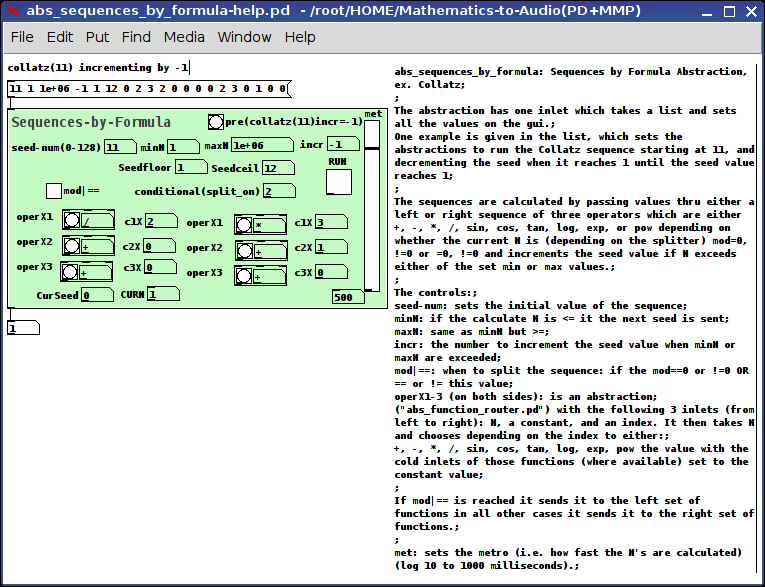
abs_sequences_by_formula-help.pd
abs_sequences_by_formula.pd (required)
abs_function_router.pd (required)
Really I was just curious to see if I could do this.
As to practical purpose: unknown (tho I Do think it's cool to stack sequences with a function router and might come in handy for those folks pursuing Sequencers)
The abstraction has one inlet which takes a list and sets all the values on the gui.
One example is given in the list, which sets the abstraction to run the Collatz sequence starting at 11, and decrementing the seed when it reaches 1 until the seed value reaches 1.
The sequences are calculated by passing values thru either a left or right sequence of three operators which are either +,-,*,/,sin,cos,tan,log,exp, or pow depending on whether the current N is (depending on the splitter) mod=0,!=0 or =0,!=0 and increments the seed value if N exceeds either of the set min or max values.
The controls:
seed-num: sets the initial value of the sequence;
minN: if the calculate N is <= it the next seed is sent;
maxN: same as minN but >=;
incr: the number to increment the seed value when minN or maxN are exceeded;
mod|==: when to split the sequence: if the mod==0 or !=0 OR == or != this value;
operX1-3 (on both sides): is an abstraction ("abs_function_router.pd") with the following 3 inlets (from left to right): N, a constant, and an index. It then takes N and chooses depending on the index to either: +,-,*,/,sin,cos,tan,log,exp,pow the value with the cold inlets of those functions (where available) set to the constant value;
If mod|== is reached it sends it to the left set of functions in all other cases it sends it to the right set of functions.
met: sets the metro (i.e. how fast the N's are calculated) (log 10 to 1000 milliseconds).
Footnote:
My intention here was to make a tool available which might allow us as pd users to show non-pd users what we mean when we say "Mathematics is 'Musical'".
Ciao!.
Have fun. Let me know if you need any help.
Peace.
Scott
MMPonBoardEditorTemplate.mmp for creation of MobMuPlat files directly on the handheld (android only)
MMPonBoardEditorTemplate.mmp for creation of MobMuPlat files directly on the handheld (android only)
MMPonBoardEditorTemplate
by svanya
INFO: make copies of this template to use as the starting point for your created .mmp files.
This template is designed to expedite the creation of simple(!) MobMuPlat files on-the-go with only the use of the handheld (i.e. does not require the Java editor).
There are three sections to this document:
the templates (in this commented section)
the mmp header just below this section
the "ENTRIES SECTION"
and
the mmp footer (which closes the .json file).
To use the template:
Open this file in a handheld text-editor (you may need to rename it, ex. adding ".txt" (no quotes) to the end of its file name to associate it to the text-editor and NOT MobMuPlat).
Copy one of the sections from this Templates Section (not including its label and the label colon and paste it into the Entries Section below and for each template you have added more than 1, add a comma after each template except the last one.
The arrangment on the screen can then be edited (in that same text editor) by amending the "frame" section of each Entry according to the following format:
"frame":[left,top,width,height]
(on the JAVA editor the screen is scaled 320px wide by 480px high)
and
Re-open the .mmp file inside MobMuPlat (renaming it back to .mmp as necessary).
Enjoy! And Good Luck! Just post any comments or help you may need here and I will try and get to them as soon as I am able.
Ciao for Now. Peace,
svanya
for those interested here is the code:
/*
MMPonBoardEditorTemplate.mmp for creation of MobMuPlat files directly on the handheld (android only)
MMPonBoardEditorTemplate
by svanya
INFO: make copies of this template to use as the starting point for your created .mmp files.
This template is designed to expedite the creation of simple(!) MobMuPlat files on-the-go with only the use of the handheld (i.e. does not require the Java editor).
There are three sections to this document:
the templates (in this commented section)
the mmp header just below this section
the "ENTRIES SECTION"
and
the mmp footer (which closes the .json file).
To use the template:
Open this file in a handheld text-editor (you may need to rename it, ex. adding ".txt" (no quotes) to the end of its file name to associate it to the text-editor and NOT MobMuPlat).
Copy one of the sections from this Templates Section (not including its label and the label colon and paste it into the Entries Section below and for each template you have added more than 1, add a comma after each template except the last one.
The arrangment on the screen can then be edited (in that same text editor) by amending the "frame" section of each Entry according to the following format:
"frame":[left,top,width,height]
(on the JAVA editor the screen is scaled 320px wide by 480px high)
and
Re-open the .mmp file inside MobMuPlat (renaming it back to .mmp as necessary).
TEMPLATES:
MMPLabel:
{"highlightColor":[1.0,0.0,0.0,1.0],"address":"/label/0","textSize":16,"color":[1.0,1.0,1.0,1.0],"androidFont":"Roboto-Bold","textFontFamily":"Default","text":"label","textFont":"","class":"MMPLabel","frame":[150.0,10.0,100.0,40.0]}
MMPButton:
{"highlightColor":[1.0,0.0,0.0,1.0],"address":"/button/0","color":[1.0,1.0,1.0,1.0],"class":"MMPButton","frame":[10.0,70.0,100.0,40.0]}
MMPToggle:
{"highlightColor":[1.0,0.0,0.0,1.0],"borderThickness":4,"address":"/toggle/0","color":[1.0,1.0,1.0,1.0],"class":"MMPToggle","frame":[10.0,130.0,100.0,40.0]}
vSlider:
{"highlightColor":[1.0,0.0,0.0,1.0],"address":"/vSlider/0","color":[1.0,1.0,1.0,1.0],"range":2,"class":"MMPSlider","isHorizontal":false,"frame":[10.0,190.0,100.0,40.0]}
hSlider:
{"highlightColor":[1.0,0.0,0.0,1.0],"address":"/hSlider/0","color":[1.0,1.0,1.0,1.0],"range":2,"class":"MMPSlider","isHorizontal":true,"frame":[10.0,250.0,100.0,40.0]}
MMPKnob:
{"highlightColor":[1.0,0.0,0.0,1.0],"address":"/knob/0","color":[1.0,1.0,1.0,1.0],"indicatorColor":[1.0,1.0,1.0,1.0],"range":2,"class":"MMPKnob","frame":[10.0,300.0,100.0,100.0]}
MMPXYSlider:
{"highlightColor":[1.0,0.0,0.0,1.0],"address":"/xyslider/0","color":[1.0,1.0,1.0,1.0],"class":"MMPXYSlider","frame":[10.0,420.0,100.0,40.0]}
MMPGrid:
{"mode":0,"highlightColor":[1.0,0.0,0.0,1.0],"borderThickness":3,"address":"/grid/0","color":[1.0,1.0,1.0,1.0],"dim":[4,3],"class":"MMPGrid","cellPadding":2,"frame":[150.0,70.0,100.0,40.0]}
MMPMultiSlider:
{"highlightColor":[1.0,0.0,0.0,1.0],"address":"/multislider/0","color":[1.0,1.0,1.0,1.0],"range":8,"outputMode":0,"class":"MMPMultiSlider","frame":[150.0,130.0,100.0,40.0]}
MMPLCD:
{"highlightColor":[1.0,0.0,0.0,1.0],"address":"/lcd/0","color":[1.0,1.0,1.0,1.0],"class":"MMPLCD","frame":[150.0,190.0,100.0,40.0]}
MMPMultiTouch:
{"highlightColor":[1.0,0.0,0.0,1.0],"address":"/multitouch/0","color":[1.0,1.0,1.0,1.0],"class":"MMPMultiTouch","frame":[150.0,250.0,100.0,40.0]}
MMPTable:
{"mode":0,"highlightColor":[1.0,0.0,0.0,1.0],"address":"/table/0","color":[1.0,1.0,1.0,1.0],"selectionColor":[1.0,1.0,1.0,0.5019608],"displayRangeLo":-1.0,"displayRangeHi":1.0,"class":"MMPTable","displayMode":0,"frame":[150.0,310.0,100.0,40.0]}
MMPPanel:
{"highlightColor":[1.0,0.0,0.0,1.0],"address":"/panel/0","color":[1.0,1.0,1.0,1.0],"passTouches":false,"class":"MMPPanel","frame":[150.0,370.0,100.0,40.0]}
THE ACTUAL MMP FILE FOLLOWS THIS
*/
{"pdFile":"osc_controller_mmp.pd","backgroundColor":[0.0,0.0,0.0,1.0],"pageCount":1,"port":54321,"isPageScrollShortEnd":false,"startPageIndex":0,"canvasType":"widePhone","gui":[
/*
ENTRIES SECTION: entries go below here and above the comment below
*/
/*
END: ENTRIES SECTION
The mmp footer is below.
*/
],"isOrientationLandscape":false,"version":1.64}
Context sequencer v3.0.1
Dear PD community
I am happy to announce the beta release of Context, a powerful new sequencer for PD. Context is a modular sequencer that re-imagines musical compositions as a networks. It combines traditional step sequencing and timeline playback with non-linear and algorithmic paradigms, all in a small but advanced GUI.
Unlike most other sequencing software, Context is not an environment. It is a single abstraction which may be replicated and interconnected to create an environment in the form of a network. There are literally endless possibilities in creating Context networks, and the user has a great deal of control over how their composition will function.
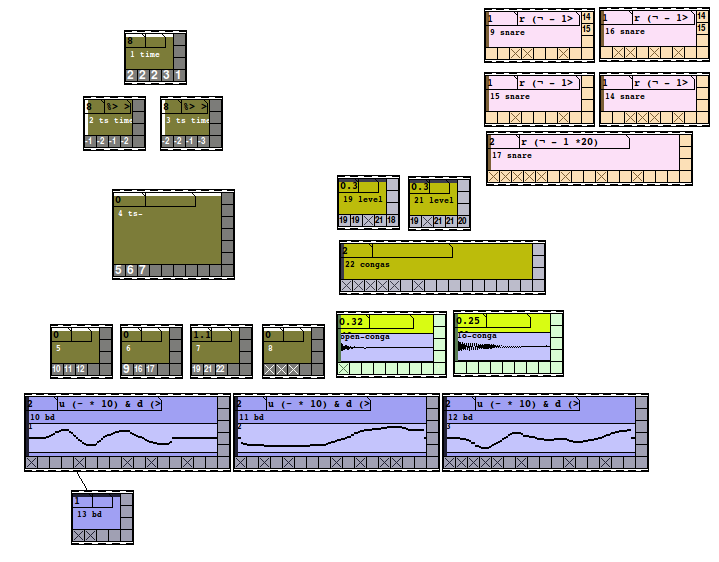
From a technical perspective, Context features a lot of things that you don't often see in PD, such as click + drag canvas resizing, dynamic menus, embeddable timelines, and fully automatic state saving. It also boasts its own language, parsed entirely within PD.
Context is work in progress--there are still lots of bugs in the software and lots of holes in the documentation. However, I have gotten it to a place where I feel it is coherent enough for others to use it, and where it would benefit from wider feedback. I am especially looking for people who can help me with proof reading and bug tracking. Please let me know if you want to join the team! Even if you can't commit to much, pointing out typos or bits of the documentation that are confusing will be very helpful to me.
Some notes on the documentation: I have been putting 90% of my efforts recently into writing the manual, and only 9% into writing the .pd help files (the remaining 1% being sleep). The help files are pretty, but the information in them is not very useful. This will be corrected as soon as I have more time and better perspective. In the mean time, please don't be put off by the confusing help files, and treat the manual as the main resource.
Context is available now at https://github.com/LGoodacre/context-sequencer.
A few other links:
-
The debut performance of Context at PDCon16~:
-
An explanation of this performance: http://newblankets.org/liam_context/context-patch.webm
-
A small demo video:
-
My paper from PDCon16~: https://contextsequencer.files.wordpress.com/2016/11/goodacre-context.pdf
Finally, I should say that this project has been my blood sweat and tears for the past 18 months, and it would mean a great deal to me to see other people using it. Please share your patches with me! And also share your questions--I will always be happy to respond.
Context only works on PD Vanilla 0.47, and it needs the following externals:
zexy
cyclone
moocow
flatgui
list-abs
iemguts (v 0.2.1 or later)
Hopefully one day it will work on L2Ork and Purr Data, but not yet.
I would like to thank the PD community for their support and inspiration, in particular Joe Deken and the organizers of PDCon16.
A couple more cute little gem things.
A couple of puredata patches rendered as gifs - mostly just 3d objects clipping in cool ways and the interactions that happen when they occupy the same space at once.




In the end I'm combining rendered videos with hand drawn stuff in visual sets like this.

Help Building Midi Generative Patches
Hi everyone,
I'm not really a programmer and i need help creating some patches that i can keep and use to generate midi for my compositions. Nothing too complex. I can't afford Max, so will have to be in either PD or Bidule i guess?
Idea 1
I need a patch that generates a metronome rhythm, just a simple note on/note off metronome for one definable note, but with the ability to control the speed of the rhythm, from slow, to really fast, on the fly and with the note length set as a percentage of the interval between notes, again changeable on the fly. This then goes out to my DAW to trigger a sample.
Idea 2
Pretty much the same as Idea 1, but with a definable range of note outputs, so as to trigger different samples within a soft sampler in the DAW, choosing each sample randomly.
Idea 3
Same as Idea 2, but output to go to a synth. So would be cool to be able to output chords and for each note on trigger to also output random triggers for lfo/cut off/other cool parameters etc. too.
Idea 4
I'd also like a simple sequence tool which outputs a short repeating predefined sequence of midi note on and note off to send to the DAW, but where I can control and change the interval/time between each note on trigger on the fly to create varied and interesting patterns and again where the note length is changeable on the fly and set as a percentage of the interval between notes.
I want to record the midi output into a DAW where i can then edit it down into the most interesting bits and build compositions.
None of the ideas need a GUI. I just want these useful tools to keep and produce works with and that I can maybe add to and develop in the future when I've learned how to program!
Any ideas, help building or tips would be really appreciated!
Thanks,
Henry
What gives a sequencer its flavor?
Hey mod, your toggle color idea is amazing. I used it to make a three-stage toggle that gives a different color on each click. So basically I can now select one of two velocities per sequencer cell. I put in a delay object so that a single click gives one value, and a double-click gives another, then a click to either value clears.
I don't see any reason why I couldn't do four-stage toggles, or five, or whatever. The implications for sequencer programming in Pd are vast and awesome. Again, props for the original idea. I've included the patch. I will clean it up and repost later (is that bad form?). The next project will be a router system that allows me to change the states of individual toggles with a single instance of the three-stage counter. Computer science can be so sexy...
Oh, and has anyone already done this, and I just didn't know it?
D

